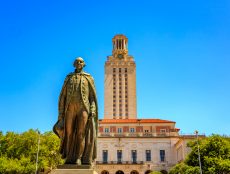
Articles
How ECOT, Once the Largest Virtual Charter School in the U.S., Went Belly-Up Overnight
By Henry Kronk
February 14, 2018
Last month, the one-time largest single virtual charter school in the U.S., Electronic Classroom of Tomorrow (ECOT), closed abruptly. The school had operated in Ohio since 2000 and had, at times, enrolled over 17,000 students by their own reporting. But during a review of the 2015-2016 school year, the Ohio School Board found that ECOT could only account for the participation of 6,300 students of its reported 15,300. A subsequent review of the 2016-2017 school year revealed 11,600 students of the 14,200 ECOT said they had enrolled.
The state of Ohio compensates charter schools on a per-student basis. For years, ECOT did very well for itself despite ongoing proof of terrible graduation rates. In 2014, less than 40% of ECOT seniors graduated. At the same time, ECOT’s founder, William Lager, did very well. The New York Times reported that in 2014, Lager’s affiliated businesses received $23 million from ECOT. In the same year, the school received $115 million in state funding.
Enrollment vs. Participation and Full-Time Equivalency at ECOT
Trouble came two years ago when Ohio stopped counting enrolled students and started to look at hours of participation and ‘full-time equivalency.’ Suddenly, those terrible graduation rates started to make sense. For the 2015-16 school year, ECOT couldn’t prove that even half of their students were enrolled full time. The next year, they closed the gap further, but still differed from their enrollment numbers by nearly 20%.
In answer, the Ohio Department of Education ordered ECOT to repay the inflated taxpayer dollars it received. The state figured that number amounts to $80 million. When the school’s charter sponsor found out in mid-January, they decided to drop their endorsement. Suddenly, nearly 12,000 students needed to find a new school.
Check here for a full timeline of the events.
ECOT continues to fought the measure that students be counted by participation, not enrollment. They argued that the Ohio Department of Education changed that measure illegally. On Tuesday, the Ohio Supreme Court heard their oral arguments.

Chief Justice Maureen O’Connor got to the heart of the matter by asking ECOT’s lawyer if the school should still receive funding for a student who is enrolled but does not participate in class.
“If enrollment is the test…that’s how it results,” said ECOT lawyer Marion Little, according to Cleveland.
“How is it not absurd?” O’Connor asked.
While other justices were more lenient in their questioning, the future looks bleak for ECOT.
A Lesson for Virtual Charter Schools Across the U.S.
The case will likely affect virtual charter schools around the country. All states impose their own different regulations on charter schools in general, but many (if not all) involve compensation on a per student basis.
The case of ECOT highlights several important takeaways when it comes virtual charter schools.
Parents should spend some time researching a given charter school before sending their kid. One might think that the widely documented poor performance of ECOT would turn away prospective students. But despite the knowledge that they were not effectively teaching their students, their enrollment increased every year through 2016. A simple Google search usually reveals some information from a trusted source. An interested parent might also inquire after SAT/ACT performance, average GPA, or state-provided performance tests compared to others in the region and country.
Another thing to remember: it’s in a charter school’s interest to enroll as many students as possible. As the Columbus Dispatch reports, ECOT spent nearly $12 million on communications, which included TV spots and other advertising. Marketing a taxpayer-funded public school seems crazy, although some have done it.
With both these factors in mind, it’s important to remember that when taxpayer dollars are on the line, for-profit educators have established a track record of defrauding their students and should be scrutinized with a higher intensity.
Finally, ECOT should not represent every virtual charter school. There will inevitably be more predatory virtual charter schools in the future, but there are also others currently doing great work. Because they don’t follow the same educational process as public brick and mortar institutions, a much greater diversity can be seen among them.
It’s also telling that, of the thousands of students who were suddenly caught without a virtual charter school to teach them, the vast majority have enrolled or applied to others in the state compared to in-person schools.
As reported by Cleveland, fewer than 100 students have sought to reenter Columbus and Cleveland school districts of the 1,200 who are eligible. Meanwhile, over 800 have already enrolled in Ohio Virtual Academy and another 1,900 have applied. Ohio Connections Academy has accepted 880 and cannot take anymore due to restrictions governing how quickly Ohio virtual charter schools can grow.









No Comments